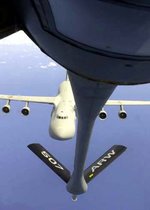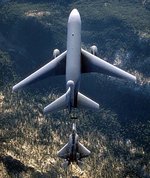Aerial refueling
|
|
Aerial refueling, also called in-flight refueling (IFR) or air-to-air refueling (AAR), is the practice of transferring fuel from one aircraft to another during flight. This allows the receiving aircraft to remain airborne longer, and to take off with a greater payload. Usually, the aircraft providing the fuel is especially designed for the task. The requirement to refuel during a flight is primarily a military requirement, and there are no known regular civilian in-flight refueling operations.
| Contents |
History and development
Some of the earliest experiments in aerial refueling took place in the 1920s, when it was as simple as two slow-flying aircraft flying in formation, with a hose run down from a handheld gas tank on one airplane and placed into the usual fuel filler of the other. It was a very dangerous process until 1935 when brothers Fred and Al Key demonstrated the first spill-free refueling nozzle, designed by A. D. Hunter. Nowadays, specialized tanker aircraft have equipment especially designed for the task of offloading fuel to the receiver aircraft, based on Hunter's design, even at the higher speeds modern jet aircraft typically need to remain airborne.
Aerial refueling systems
The two most common approaches for making the union between the two aircraft are the boom and receiver system and the probe and drogue system. Much less popular was the wing-to-wing system, which is no longer used.
Boom and receiver
The boom is a long, rigid, hollow shaft, usually fitted to the rear of the aircraft. (It almost connects the two lower aircraft in the picture at right.) It usually has a telescoping extension, a valve at the end to keep fuel in and permit it to flow, and small wings, sometimes known as ruddevators depending on design particulars (visible in picture below, in the "V" shape), to enable it to be "flown" into the receiver of the aircraft to be refueled. This receiver is fitted onto the top of the aircraft, on its centerline and usually either behind or close in front of the cockpit. The receiver is a round opening which connects to the fuel tanks, with a valve to keep the fuel in when not being refueled, and dust and debris out. The boom has a nozzle which fits into this opening.
During refueling operations, a tanker aircraft will fly in a straight and level attitude at constant speed, while the receiver takes a standard position behind and below the tanker. Modern tankers have lights which illuminate the areas outside this range, so that if the pilot can see them, he is directed to fly back towards the desired spot. Once in position, the receiver pilot flies formation with the tanker, although this can be complicated by wake turbulence. The crewman operating the boom, called a boomer or boom operator (in the USAF, usually an enlisted sergeant), then unlatches the boom from its stowage position, and directs it towards the receiver by "flying" it with the attached wings. The telescoping section is then hydraulically extended until the nozzle fits into the receiver. When an electrical signal is passed between the boom and receiver, both valves are hydraulically opened, and pumps on the tanker drive fuel through the shaft of the boom, and into the receiver. Once the two are mated up, additional lights on the tanker will be turned on if the receiver flies too far to one side, too low or too high, or too near or too far away, activated by sensing switches in the boom. When fueling is complete, the valves are closed and the boom is automatically retracted. In addition to being used by the US Air Force, the boom method is used by the Netherlands (KDC-10) and Israel (modified Boeing 707). Both nations operate US designed aircraft.
 USAF C-5 approaches a KC-135R | Missing image F-15_wingtip_vortices.jpg An F-15 Eagle disengages from a KC-10 Extender. | Missing image Usaf.f15.f16.kc135.750pix.jpg USAF KC-135R Stratotanker, two F-15s (twin fins) and two F-16s, on an aerial refueling training mission. |
Probe and drogue
GR4_VC10.jpg
The drogue (or para-drogue), sometimes called a basket, is a fitting resembling a plastic shuttlecock, attached to a flexible hose at its narrow end, with a valve where the two meet. The receiver has a probe, which is a rigid, sometimes jointed, arm placed usually on the side of the airplane.
Again, the tanker flies straight and level, and the drogue is allowed to trail out behind and below it. The drogue is not controllable other than by flying the tanker, so the receiver pilot must fly his probe directly into the basket, at which point wind drag on the basket forces the probe into the valve, which opens to allow fuel to be pumped through. The receiver maintains his position during refueling, keeping an eye on the hose to make sure he remains in a suitable position. When fueling is complete, he decelerates hard enough to yank the probe out of the basket.
Some boom-carrying tankers have special hoses which can be attached to the nozzle of the boom to allow them to also refuel probe-equipped aircraft. Others may have both a boom and one or more hose-and-drogue assemblies equipped. The U.S. Navy, Marine Corps, and other NATO nations use this system, rather than the boom system.
This system was first used on late models of the KB-29M Superfortress. Its first use in combat occurred on May 29 1952 when twelve F-84s were refueled during a mission from Itazuke, Japan to Sariwon, North Korea.
Wing-to-wing
In this method, the tanker aircraft was releasing a flexible hose from its wingtip. An aircraft, flying beside it, had to catch the hose with a special lock under its wingtip. After the hose was locked, and the connection was established, the fuel was pumped. It was used on a small number of Soviet Tu-4 and Tu-16 only (the tanker variant was Tu-16Z).
Strategic and tactical implications

| It is requested that this article, or a section of this article, be expanded See the request on the listing or elsewhere on this talk page. Once the improvements have been completed, you may remove this notice and the page's listing. |
Strategic uses and considerations
Refuelling.750pix.jpg
The early development of the KC-97 and KC-135 Stratotankers was inspired by the desire of the United States to be able to keep fleets of B-47 Stratojet and B-52 Stratofortress strategic bombers aloft during the Cold War, either to retaliate against a Soviet strike and ensure Mutual Assured Destruction, or to bomb the U.S.S.R. first had it proven necessary. The bombers would fly orbits around their assigned positions from which they were to enter Soviet airspace if they received the order, and the tankers kept the bombers' fuel tanks full so that they could keep a force in the air 24 hours a day, and still have enough fuel to reach their targets in the Soviet Union. This also ensured that a first strike against the bombers' airfields could not obliterate the U.S.'s ability to retaliate. A famous example of refueling used in this manner in movies can be seen in the opening credits of Dr. Strangelove or: How I Learned to Stop Worrying and Love the Bomb (a fictional movie, but the scenes are from actual B-52 refueling).
A byproduct of this development effort and the building of large numbers of tankers was that these tankers were also available to refuel cargo aircraft, fighter aircraft, and ground attack aircraft, in addition to bombers, for ferrying to distant theaters of operations. This was much used during the Vietnam War, when many aircraft could not have covered the transoceanic distances without aerial refueling, even with intermediate bases in Hawaii and Okinawa. In addition to allowing the transport of the aircraft themselves, the cargo aircraft could also carry matériel, supplies, and personnel to Vietnam without landing to refuel.
Tactical uses and considerations
The capability of refueling after takeoff conveys two considerable tactical advantages to those with tankers. Most obviously, it allows attack aircraft, fighters, and bombers to reach distances they couldn't otherwise, and patrol aircraft to remain airborne longer. Additionally, since an aircraft's maximum takeoff weight is generally less than the maximum weight with which it can stay airborne, this allows an aircraft to take off with only a partial fuel load, and carry additional payload weight instead. Then, after reaching altitude, the aircraft's tanks can be topped off by a tanker, bringing it up to its maximum flight weight.
Vietnam War
In addition to ferrying aircraft across the Pacific Ocean, Aerial refueling made it possible for damaged fighters to hook up to the tankers and be towed to the point where they could glide to the base and land. This saved countless lives, and is one of the greatest uses of tanker aircraft in that theater.
Falklands War
Aerial refueling during the Falklands War was carried out almost exclusively by the Handley Page Victor. These aircraft aided deployments from the UK to the Ascension Island staging post in the South Atlantic and further deployments south of attack, transport and maritime patrol aircraft. The most famous refueling missions were the "Operation Black Buck" sorties which involved Victor tankers refueling Avro Vulcan bombers to attack Argentine forces on the Falkland Islands. These missions had the effect of deterring the Argentine Air Force from deploying aircraft on the Falklands, these jets were held back in defence of the Argentine mainland.
Gulf War
Kosovo War
Media
Template:Multi-video start Template:Multi-video item Template:Multi-video end
Tanker aircraft by refueling system
Boom and receiver
B2_KC-135_Refuel.jpg
- KB-29P
- adapted from the B-29 Superfortress
- KC-97 Stratotanker
- adapted (heavily) from the B-29 Superfortress
- KC-135 Stratotanker
- adapted from the Boeing 707
- can also use drogue adapter
- T models will have two drogue hose reels at the wingtips
- KC-10 Extender
- adapted from the McDonnell Douglas DC-10
- (also has a retractable hose and drogue)
- KC-767
- adapted from the Boeing 767
- used by Italy and Japan; not yet in U.S. military service
- Airbus A330 MRTT
- development of Airbus A330 - 5 Australian aircraft will be equipped with both a flying boom and probe and drogue units. (UK aircraft probe and drogue only.)
Probe and drogue
- Airbus A330
- RAF Future Strategic Tanker Aircraft, due in service around 2008.
- Airbus A310 MRTT
- 4 for Luftwaffe
- 2 for Canadian Forces (as CC-150 Polaris)
- Avro Vulcan
- specially modified for operations during the Falklands War
- Blackburn Buccaneer
- Equipped for buddy tanking
- Boeing 707
- Used by the South African Air Force and others
- KB-29M
- adapted from the B-29 Superfortress; earlier versions used a "grappling hose" system, later models used a true probe-and-drogue
- KB-50
- also adapted from the B-29 Superfortress
- HC-130 Hercules and KC-130 Hercules
- variants of the C-130 Hercules
- Lockheed L-1011 Tristar
- K1 and KC1 variants deployed by the Royal Air Force and Canadian Forces Air Command
- Vickers Valiant
- Vickers VC-10
- Handley Page Victor
- KA-3
- KA-4
- Equipped for buddy tanking
- KA-6
- KA-7
- S-3 Viking
- Current primary carrier-based tanker
- F/A-18E/F
- equipped for buddy refueling as "Strike tankers"
- Il-78 Midas
- Standard Russian tanker, adapted from Il-76
- Myasishchev M-4-2
- adapted from the M-4 bomber
- Myasishchev 3MS-2
- adapted from the 3M bomber
- Tu-16N (and Tu-16Z with wing-to-wing system)
- Su-24M
- equipped for buddy refueling with the UPAZ container as "Strike tankers"
See also
Regarding spacecraft: see Docking maneuver.da:Tankfly de:Luftbetankung es:Reabastecimiento_en_vuelo fr:Avion ravitailleur ja:空中給油 pl:Tankowanie w powietrzu fi:Ilmatankkaus

